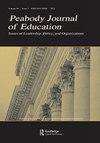不景气时期的支出:大萧条时期德州学校级别的预算分配
Q2 Social Sciences
引用次数: 2
摘要
本文的目的是增加现有的知识,即在严重的经济衰退期间,建筑水平的支出如何优先考虑水平和垂直的公平。我们以大衰退期间德克萨斯州所有公立学校为样本,研究了支出削减幅度最大的学校如何重新分配其在学术项目上的支出。结果表明,遭受财政冲击的学校主要通过重新分配常规、加速和特殊教育支出来应对,而不是简单地实施全面削减。高贫困、低绩效和城市学校倾向于优先分配给目标群体支持,而低贫困、高绩效的郊区学校倾向于优先分配给常规教育支持。此外,固定效应和随机效应回归模型的结果表明,虽然支出分配部分取决于地区层面的特征,但支出的反动变化更多地由学校或领导特征来解释。这些结果支持了这样一种观点,即在经历财务不确定时期时,在确保支出符合当前学生需求方面,校级预算是一个重要因素。本文章由计算机程序翻译,如有差异,请以英文原文为准。
Spending in Lean Times: School-Level Budget Allocations During the Great Recession in Texas
ABSTRACT The intention of this paper is to add to existing knowledge of how building-level spending is prioritized toward horizontal and vertical equity during severe economic downturns. Using a sample of all public schools in Texas during the Great Recession, we examine how schools undergoing the greatest spending reductions reallocated their spending on academic programs. Results demonstrate that schools undergoing financial shocks respond mainly by reapportioning regular, accelerated, and special education spending, rather than simply enacting across-the-board cuts. High-poverty, low-performing, and urban schools tended to prioritize reallocations toward targeted group support, while lower poverty, higher performing, suburban schools tended to prioritize reallocations toward regular education support. Furthermore, results of fixed and random effect regression models suggest that while spending allocations are in part determined by district-level characteristics, reactionary changes to spending are more explained by school or leadership characteristics. These results support the notion that site-level budgeting is an important factor in ensuring that spending is calibrated to current student needs when undergoing periods of financial uncertainty.
求助全文
通过发布文献求助,成功后即可免费获取论文全文。
去求助
来源期刊

Peabody Journal of Education
Social Sciences-Education
CiteScore
2.20
自引率
0.00%
发文量
43
期刊介绍:
Peabody Journal of Education (PJE) publishes quarterly symposia in the broad area of education, including but not limited to topics related to formal institutions serving students in early childhood, pre-school, primary, elementary, intermediate, secondary, post-secondary, and tertiary education. The scope of the journal includes special kinds of educational institutions, such as those providing vocational training or the schooling for students with disabilities. PJE also welcomes manuscript submissions that concentrate on informal education dynamics, those outside the immediate framework of institutions, and education matters that are important to nations outside the United States.
 求助内容:
求助内容: 应助结果提醒方式:
应助结果提醒方式:


